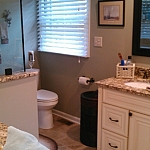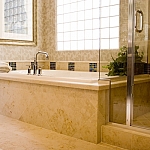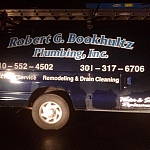Frequently Asked Questions
Robert G. Bookhultz Plumbing Inc. has dealt with all types of plumbing issues over the past 35 years. We wanted to share some of this knowledge with you. Below you will find answers to the most frequently asked questions we have received. If you don't find the answer you are looking for, please fill out our contact form or give us a call!
Q. What are the most common causes of pipe corrosion?
- Chemicals in the water
- The pH of the water
- The amount of oxygen in the water
- The temperature of the water
- The water pressure and the speed at which the water moves through the pipes.
Water Heaters
Q. When should I drain my water heater and how often should I drain it?
A. You are not required to drain your water heater and it is recommended that you don't - despite popular belief. When you drain teh water heater you are stirring up all the sediment that has collected at the bottom which then forces it out into you pipes causing poor water pressure and clogged faucets.
Q. The water does not stay hot for as long as it used to, do I need to replace my water heater?
A. There are two main causes for the lack on hot water, both of which would not require replacement of the whole water heater unit. The first would be if you have an electric water heater one of the heating elements may not be opperating properly or the thermostat has malfunctioned and would need to be replaced. The other main reason would be that the dip tube has broken off inside the tank and is now allowing the incoming cold water to mix with the hot water insterad of being forced to the bottom, this is true for both gas and electric water heaters.
Q. What is the best temperature to set my water heater at?
A. There are a several different temperatures you can set your water heater to so you can set it to what ever you and your family are comfortable with. Most people are comfortable with their water heaters set to 120⁰F which is the new standard manufacturers pre-setting. If you have an older model than more than likely yours is at the medium setting. On electric models you have to adjust the thermostats (there may be two) which are located behind two panels on the side of the tank NOTE: be sure to turn off all electrcity to the water heater before removing these panels and you can adjust the setting to the desired temperature. If you have a gas water heater there is a dial on the front of the gas valve which allows you to adjust it to the desired temperature.
High Water Bills
Q. My water bill recently appears to be rather high and none of my faucets seem to be leaking, is there anything else that could be causing the sudden increase?
A. The first thing you should check is your toilets, make sure they are not leaking. Then you can check to make sure your fill valve, inside the tank, is not overflowing through the overflow pipe. There is a small tube that should be connected to it, you want to make sure the water level is about 1 inch below the overflow tube or level with the manufacturers mark inside the tank. The last thing you can check is your flapper. You can do this by adding a couple of drops of some food coloring to your tank water, let it sit for about 15-20 minutes and check to see if the water in you bowl has changed color. If it has then you will need to replace your flapper.
Q. My faucets only drip a little bit every now and then, should I replace them?
A. More than likely you will not need to replace the faucet. If it is dripping from the spout than replacing the seats and springs or the ball valve could be all you need to do. If it is dripping from the supply lines underneath a simple tightening of the fittings might solve the problem. However if it is dripping from underneath the faucet itself you may have to replace it and this can be discussed with your plumber.
Q. I have checked all my faucets, toilets, and outside hosebib none are running or appear to be leaking but my meter is still spinning, what's going on?
A. If you have checked all your water sources the next step would be to check your meter box and make sure there is no water leaking there. After that you can check you water heater to make sure the overflow pan is not holding water. If it is then either your tank or your relief valve is leaking and needs to be replaced. Then lookover your yard and see if there are any drak green spots where the grass is richer and more moist, if you find a spot like that you may have a leak on your main water line that would need to be repaired.
Strange Noises
Q. I can hear a strange whistling sound when I flush one of my toilets?
A. There could be a few reasons you hear whistleing noise's when your toilet is flushed, the most common being: a small chip or hole in your tank cover is allowing air to pass through at a high rate of speed causing the whistle noise. It could also be caused by you fill valve and a simple adjustment would stop the noise.
Q. I can hear a low whinning noise coming from my water heater, what could be the cause of this?
A. This typically is a normal sound when your water heater is re-filling after having used hot water, however if you are hearing this when you do not have any water sources running you may have a leak on one of you hot water lines and should call a plumber for further assistance.
Q. I can hear a banging noise that seems to be coming from my pipes?
A. A banging noise is usually caused by a worn out or faulty hammer restor, these are installed on your automatic water lines such as your ice maker line, your dishwasher line, or your washing machine line. A simple replacement of the hammer restor will stop the banging noise.
Q. I can hear water running inside my walls, what does that mean.
A. If you can hear water running inside your walls and there are no water sources turned on then you may have a leak from one of the water pipes, you should call a plumber for further advisement
Slow drains or Clogged drain line
Q. The sink in master bathroom is draining really slow.
A. If you are having trouble with just one sink draining, then more than likely you have a stoppage in the immediate drain line. These can usaully be removed by using a drain snake to clear the line. However if it is further down the line you might not be able to reach it with a regular drain snake, and you should call your plumber. If the water is draining slowly then you might have what is referred to as a partial stoppage which is allowing some water to pass through at a much slower speed. The first thing you should check is the pop-up to make sure there isn't any obstructions like hair in the line. If there are no obstructions that you can see, you can try using a drain cleaner to remove the debris in the line.
Low water pressure or Loss of water flow
Q. We used to have great water pressure in the master bath shower but it seems to be very low now?
A. If you are experiencing low water pressure where you once had good water pressure there could be several possibilities. The first thing you should check is the supply line, make sure it is turned all the way on. Another common reason is the aerators are clogged, simply unscrew the aerator from the faucet head and clean out the sediment that may have collected by soaking it in vinager overnight then using an old toothbrush just bush out the buildup. If you are still experiencing low water pressure you should call your plumber for further advise.
Q. We used the faucet yesterday but when we turned it on this morning no water came out.
A. If you are experiencing loss of water throughout your home the first thing you should check is the main water shut off valve and make sure it is fully in the on position, the shut off is typically located in your garage, but can be different depending on where you live. If the main shut off valve is completely turn on but you still don't have water then check to make sure there is no breaks in your main water line, if there is please call your plumber for further assistance. If you are experiencing no water flow at only one faucet then first check to make sure the supply line is turned on, more than likely you have one of 2 types of shut off valves: a "twist turn" to open and close the valve or a "push-pull". If your supply lines are in the "on" position and you still don't have any water flow then check to make sure there is no sediment build up in the aerator, if there is then removing the sediment should restore water flow. If you still do not have water flow then you should call your plumber for further advise.
Foul odors
Q. We have a guest bathroom that we hardly ever use unless company comes and there is a fowl odor coming from the shower.
A. Your plumbing system is designed to block out these sewer odors by way of the P-traps that are attached to each fixture. These traps contain water which seals out the smell, however if the water evaporates than the odors are allowed into the home. To solve this issue take a bucket full of water and pour it in to each of the drains you are experiencing an odor through. This should block out and prevent the odor. If it is a shower or sink you do not use often you may want to make this a part of your regular cleaning routine to prevent any future occurances.
Toilets and Toilet Replacement
Q. We are currently looking to replace one of our toilets, but I have heard that the new toilet models do not flush properly and sometimes require multiple flushes to wash everything down.
A. In 1994 a law was mandated by the federal government to regulate that the new toilets were to use no more than 1.6 gallons of water per flush. The manufacturers then had to develope a toilet that would properly clear the bowl and carry the waste to the septic system or the city sewer. The first models that were introduce were cause for complaint, so the manufacturers have developed new flushing technology and enlarged internal passageways resulting in a properly functioning toilet. There is also a toilet known as a powerflush commode which uses a pressurized tank to produce a surge of water that enters and clears the bowl of any waste. Although they are not as quite as convetional models they work well, and are like commercial toilets.
Q. We can see the toilet bubbling when we drain the tub, what would cause this?
A. If you can hear or see the toilet bubbling when water is draining then you may have a partial stoppage somewhere in the drain line. This could also mean your septic tank is full and would need to be drained by a septic company. However If this is a common occurance then you might want to consider having a plumber run a sewer camera though your drain line to check for obstuctions, a possible break in the line, or even root growth in your drain line.








